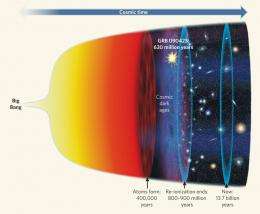In a Galaxy Far, Far Away...

(PhysOrg.com) -- Astronomers have published the discovery of the farthest known object in the cosmos: a star that exploded when the universe was only 630 million years old -- only 4.6% of its current age. Light from this cataclysm had been traveling towards us for about 13 billion years, finally arriving here last April 23.
It was spotted only because the dying star was bright -- it emitted as much energy in its final moments as the sun emits in about a billion years of life -- and of course because astronomers had been searching for just such activity.
The explosion was from a gamma ray burst (GRB). The brightest events in the known universe, GRBs occur about once a day, randomly, from around the sky; most of them shine for minutes -- relatively short times -- and are found in the midst of galaxies. They are thought to be produced in extreme kinds of supernovae, the explosive deaths of massive stars. Scientists study GRBs not only to understand the nature of these dramatic explosions and the final moments of a giant star's life, but also because GRBs are cosmic beacons that can be seen from very far away.
CfA astronomer Edo Berger is a member of a large team of international scientists who report in this week's Nature on the discovery of the most distant GRB -- and the most distant object of any kind -- that is known. The burst itself was spotted by NASA's Swift satellite, a mission designed specifically to find these fleeting events and to facilitate quick follow-up observations. The team then used five ground-based telescopes with different instruments to stare at the precise location in the sky where the GRB occurred, hoping to detect the aftermath of the explosion. They found nothing in the optical, but they were able to detect a glow at several infrared wavelengths. Such a very red color is characteristic of an object at cosmological distances, and the team's measurements were sufficiently precise that they could locate it, with a formal uncertainty of less than one percent, to a time when the universe was very young.
The results are exciting because they extend our direct knowledge of the early cosmos back into an era that otherwise is rather mysterious. It is not known, for example, whether stars at these early epochs would even produce conventional GRBs or supernovae; they might instead be so unlike stars in our current environment, lacking in many of the chemical elements that were produced over eons of time, that their properties would be strange. The new paper, besides describing the discovery, presents evidence to tentatively suggest that at least this particular star and its dramatic demise do seem to resemble cases found in the more familiar, local universe.
More information: Blast from the Past Gives Clues About Early Universe
Provided by Harvard-Smithsonian Center for Astrophysics (news : web)


















